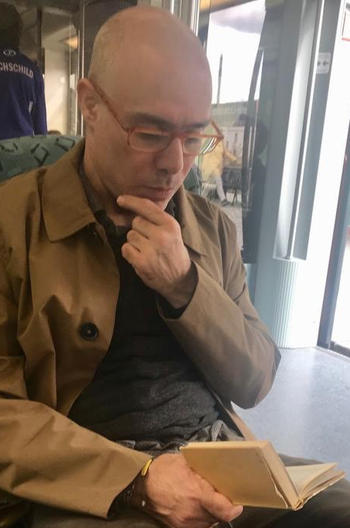Dr. Istvan Pal Adam

EDUCATION
- PhD in Historical Studies, University of Bristol, UK, 2010-2015
Thesis Title: “Bystanders” to Genocide?: The Role of Building Managers in the Hungarian Holocaust
- MA in History, Central European University, Budapest, Hungary, 2008-2009
Thesis Title: Post-Holocaust Pogroms in Poland and Hungary
- Walter Benjamin Fellow, Paideia European Institute for Jewish Studies, Stockholm, Sweden, 2009-2010
- BA in History and in Law, University of Szeged, Hungary, 1996-2003
RELATED WORK EXPERIENCE
- Postdoctoral Fellowship jointly sponsored by the Simon Dubnow Institute and the Vienna Wiesenthal Institute for Holocaust Studies, 1 February, 2018 – 30 April, 2019
- Postdoctoral Researcher at CEFRES/Charles University, Prague, 01 January, 2016 –31 December, 2017
- Junior Fellow at the Vienna Wiesenthal Institute for Holocaust Studies, 1 March, 2014 – 1 September, 2014
- Tziporah Wiesel Fellow at the Centre for Advanced Holocaust Studies, United States Holocaust Memorial Museum, Washington DC, 1 December, 2012 – 31 May, 2013
- EHRI/European Holocaust Research Infrastructure Fellowship at Yad Vashem, 1 October, 2012 – 30 November, 2012
- Holocaust Compensation Officer at the Hungarian Ministry of Justice, Compensation Department, 1 October 2006, – 30 September, 2010
LANGUAGES SPOKEN
- Hungarian – native language
- English – fluent (speaking, reading, writing)
- Polish – intermediate (speaking, reading), basic (writing)
- German – basic (speaking and reading)
- History of Jewish minorities and Jewish emancipation
- Holocaust studies and the commemoration of the Shoah in East-Central Europe
- Professional social histories between 1850 and 1950
- Antisemitism in East-Central Europe in the nineteenth and twentieth centuries
Monograph
Budapest Building Managers and the Holocaust in Hungary, Cham: Palgrave Macmillan, 2016.
(ISBN: 9783319338309 and 9783319338316 3319338315)
Essays and Articles
When a rabbi says “no”: Post-Holocaust pogroms in Poland and in Hungary and the differences in commemoration; Book chapter in August Grabski (ed.), Pogromy Żydów na ziemiach polskich w XIX i XX w., vol. 4: Holokaust i powojnie (1939-1946), Warsaw: Instytut Historii IHP PAN, 2019, pp. 617-645. (ISBN 978-83-65880-24-6)
Dr. Géza Dombováry and the Budapest Circle of Jewish Legal Defenders: a Cultural History 1871-1921, in S:I.M.O.N., the online journal of Vienna Wiesenthal Institute for Holocaust Studies, vol. 6, issue 2 (November, 2019), no. 2, pp. 56-74. (DOI: 10.23777/SN0219/ART_IPAD01)
Házmesterek a vészkorszakban [Concierges and the Shoah], in: Századok vol. 153 (2019), no. 4, pp. 691-713.
Paramilitary Extremism in Interwar Hungary and its Anti-Jewish Argumentation, in: Střed/Centre. Journal for Interdisciplinary Studies of Central Europe in the 19th and 20th Centuries vol. 9 (2017), no. 1, pp. 9–33.
Hentesek, hatalom, holokauszt [Butchers, power and the Holocaust], in: Pannonhalmi Szemle [Pannonhalma Review] vol. 25 (2017), no. 3, pp. 39–59.
A házmesterek szerepe a magyar holokausztban [The role of building managers in the Hungarian Holocaust], book chapter in Randolph L. Braham (ed.), Tanulmányok a holokausztról [Studies on the Holocaust], vol. 6, Budapest: Múlt és Jövő, 2014, pp. 103–137.
Reviews
Zoltán Paksy, A nagykanizsai zsidóság és a Holokauszt [The Jewish Community of Nagykanizsa and the Holocaust], Nagykanizsa 2014, in: URBS, Magyar Várostörténeti Évkönyv [Hungarian Urban History Yearbook] vol. 12 (2017), pp. 395–399.
Ildikó Barna/Andrea Petö, Political Justice in Budapest after World War II, Budapest 2015, in: Hungarian Historical Review vol. 4 (2015), no. 3, pp. 790–795.
Zsuzsanna Ozsváth, When the Danube Ran Red, Syracuse, N. Y. 2010, in: Journal of Jewish Identities vol. 5 (2012), no. 2, pp. 85–88.
